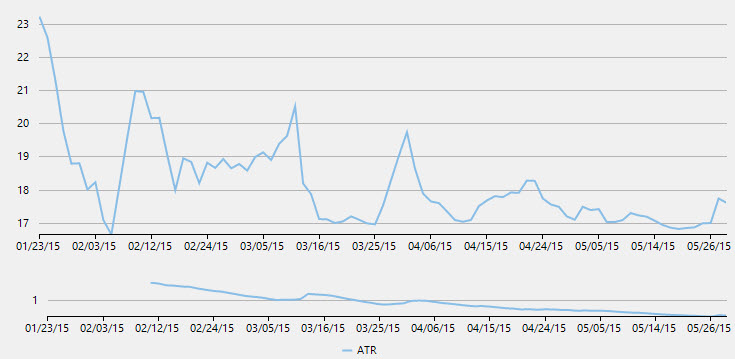Average True Range
Average True Range (ATR) is a technical indicator for measuring the volatility of an asset. It does not provide an indication of the price trend, but of the degree of the price volatility. It is typically based on 14 periods, and could be calculated intra daily, daily, weekly or monthly basis. Stocks having high volatility will have a higher ATR, while low volatility stocks will have a lower ATR.
FinancialChart also enables you to fetch the calculated ATR values at run-time using GetValues() method. This can help in creating alerts in application or maintaining logs while working with dynamic data.
The following code snippet creates an instance of the ATR class to use Average True Indicator. Also, the sample uses a class DataService.cs to get data for the financial chart.
Public Class DataService
Public Class DataService
Private _companies As New List(Of Company)()
Public Sub New()
_companies.Add(New Company() With {
.Symbol = "box",
.Name = "Box Inc"
})
_companies.Add(New Company() With {
.Symbol = "fb",
.Name = "Facebook"
})
End Sub
Public Function GetCompanies() As List(Of Company)
Return _companies
End Function
Public Function GetSymbolData(symbol As String) As List(Of Quote)
Dim path As String = String.Format("FinancialChartExplorer.Resources.{0}.json", symbol)
Dim stream = Assembly.GetExecutingAssembly().GetManifestResourceStream(path)
Dim ser = New System.Runtime.Serialization.Json.DataContractJsonSerializer(GetType(Quote()))
Dim data = DirectCast(ser.ReadObject(stream), Quote())
Return data.ToList()
End Function
Shared _ds As DataService
Public Shared Function GetService() As DataService
If _ds Is Nothing Then
_ds = New DataService()
End If
Return _ds
End Function
End Class
Public Class Quote
Public Property [date](/componentone/docs/win/online-financialchart/Analytics/Indicators/AverageTrueRange) As String
Get
Return m_date
End Get
Set
m_date = Value
End Set
End Property
Private m_date As String
Public Property high() As Double
Get
Return m_high
End Get
Set
m_high = Value
End Set
End Property
Private m_high As Double
Public Property low() As Double
Get
Return m_low
End Get
Set
m_low = Value
End Set
End Property
Private m_low As Double
Public Property open() As Double
Get
Return m_open
End Get
Set
m_open = Value
End Set
End Property
Private m_open As Double
Public Property close() As Double
Get
Return m_close
End Get
Set
m_close = Value
End Set
End Property
Private m_close As Double
Public Property volume() As Double
Get
Return m_volume
End Get
Set
m_volume = Value
End Set
End Property
Private m_volume As Double
End Class
Public Class Company
Public Property Symbol() As String
Get
Return m_Symbol
End Get
Set
m_Symbol = Value
End Set
End Property
Private m_Symbol As String
Public Property Name() As String
Get
Return m_Name
End Get
Set
m_Name = Value
End Set
End Property
Private m_Name As String
End Class
End Classpublic class DataService
{
List<Company> _companies = new List<Company>();
public DataService()
{
_companies.Add(new Company() { Symbol = "box", Name = "Box Inc" });
_companies.Add(new Company() { Symbol = "fb", Name = "Facebook" });
}
public List<Company> GetCompanies()
{
return _companies;
}
public List<Quote> GetSymbolData(string symbol)
{
string path = string.Format("FinancialChartExplorer.Resources.{0}.json", symbol);
var stream = Assembly.GetExecutingAssembly().GetManifestResourceStream(path);
var ser = new System.Runtime.Serialization.Json.DataContractJsonSerializer(typeof(Quote[]));
var data = (Quote[])ser.ReadObject(stream);
return data.ToList();
}
static DataService _ds;
public static DataService GetService()
{
if (_ds == null)
_ds = new DataService();
return _ds;
}
}
public class Quote
{
public string date { get; set; }
public double high { get; set; }
public double low { get; set; }
public double open { get; set; }
public double close { get; set; }
public double volume { get; set; }
}
public class Company
{
public string Symbol { get; set; }
public string Name { get; set; }
}Dim atr As New ATR() With
{
.Name = "ATR"
}
Dim dataService__1 = DataService.GetService()
Dim data = dataService__1.GetSymbolData("box")
FinancialChart1.BeginUpdate()
FinancialChart1.BindingX = "date"
FinancialChart1.Binding = "close"
FinancialChart1.Series.Add(New FinancialSeries())
FinancialChart1.ChartType = C1.Chart.Finance.FinancialChartType.Line
FinancialChart1.DataSource = data
FinancialChart1.Rendered += Function(s, a)
financialChart2.AxisX.Min = FinancialChart1.AxisX.ActualMin
financialChart2.AxisX.Max = FinancialChart1.AxisX.ActualMax
End Function
FinancialChart1.EndUpdate()
financialChart2.BeginUpdate()
financialChart2.ChartType = C1.Chart.Finance.FinancialChartType.Line
financialChart2.BindingX = "date"
financialChart2.Binding = "high,low,close"
financialChart2.Series.Add(atr)
financialChart2.Legend.Position = C1.Chart.Position.Bottom
financialChart2.DataSource = data
financialChart2.EndUpdate()
period.Value = atr.PeriodATR atr = new ATR() { Name = "ATR" };
var dataService = DataService.GetService();
var data = dataService.GetSymbolData("box");
financialChart1.BeginUpdate();
financialChart1.BindingX = "date";
financialChart1.Binding = "close";
financialChart1.Series.Add(new FinancialSeries());
financialChart1.ChartType = C1.Chart.Finance.FinancialChartType.Line;
financialChart1.DataSource = data;
financialChart1.Rendered += (s, a) =>
{
financialChart2.AxisX.Min = financialChart1.AxisX.ActualMin;
financialChart2.AxisX.Max = financialChart1.AxisX.ActualMax;
};
financialChart1.EndUpdate();
financialChart2.BeginUpdate();
financialChart2.ChartType = C1.Chart.Finance.FinancialChartType.Line;
financialChart2.BindingX = "date";
financialChart2.Binding = "high,low,close";
financialChart2.Series.Add(atr);
financialChart2.Legend.Position = C1.Chart.Position.Bottom;
financialChart2.DataSource = data;
financialChart2.EndUpdate();
period.Value = atr.Period;


